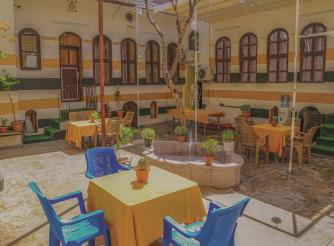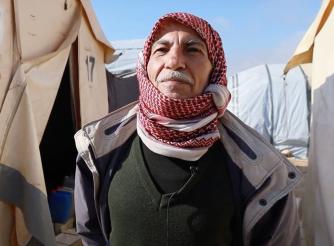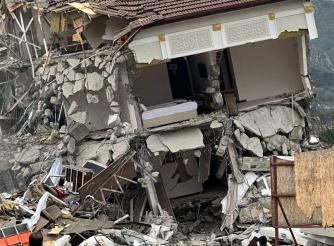Policy paper: Shaping localised recovery in Northwest Syria
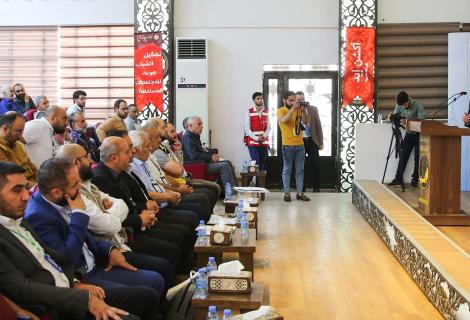
A note to the reader: This policy paper was drafted before the collapse of the Assad regime in Syria. ActionAid still believes strongly in the role of youth in early recovery, and we fully support them in their leadership role on this journey.
Moving from rhetoric to action
In the midst of a protracted twelve-year crisis, the recent devastating earthquakes have added yet another layer of complexity and urgency to the situation. As the affected population grapples with the aftermath of the recent crisis, the uncertainty around the cross-border resolution has dealt a severe blow to the humanitarian situation in the Northwest of Syria, and the task of shaping a localised recovery strategy becomes paramount to restore stability, rebuild communities, and address the urgent needs of the affected population.
This policy brief is the culmination of extensive community consultations and a local conference conducted in Northwest Syria, which brought together diverse voices, including youth, women, key stakeholders, and, most importantly, individuals directly affected by the crisis.
By adopting a locally led approach, this paper aims to provide a comprehensive framework that prioritises the perspectives and aspirations of the crisis-affected people, ensuring that their voices are not only heard but also central to the recovery process.
DOWNLOAD A PDF OF THE POLICY PAPER HERE OR READ IT IN FULL BELOW
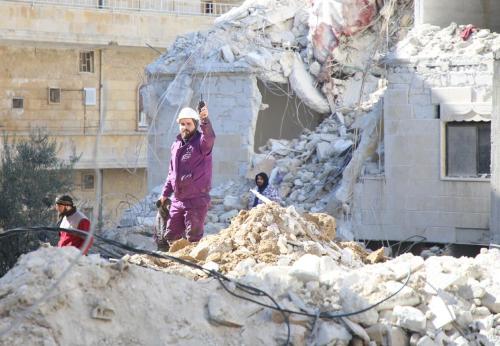
The significance of engaging local voices, particularly those of youth and women, cannot be overstated. Their unique experiences, insights, and innovative ideas form an integral part of developing effective solutions that address the multifaceted challenges faced by communities recovering from the aftermath of the earthquakes and the never ceasing humanitarian crises. By actively involving these marginalised groups, we can ensure that the recovery efforts are inclusive, equitable, and sustainable, leaving no one behind. Furthermore, the involvement of key stakeholders in this collaborative process underscores the commitment to a participatory approach. By bringing together representatives from educational bodies, civil society organisations, humanitarian agencies, and the private sector, a platform for diverse perspectives and expertise to converge was created, fostering the development of a comprehensive and holistic recovery strategy. The collective wisdom and shared responsibility among these stakeholders will lay the foundation for effective implementation and long-term impact.
Importantly, the local consultations and the conference that informed this policy brief prioritised the perspectives and needs of crisis-affected individuals. These individuals, who have experienced firsthand the devastating consequences of the protracted crisis, possess invaluable knowledge and insights that must guide our recovery efforts. Their lived experiences not only shed light on the immediate challenges but also offer crucial lessons for building resilience and fostering community-led solutions.
This policy brief recognises the agency and resilience of crisis-affected people and seeks to amplify their voices in decision-making processes. It emphasises the importance of local context, cultural sensitivity, and community ownership to ensure that the recovery efforts align with the specific needs and aspirations of the affected population, not only to empower communities but also to enhance the effectiveness and sustainability of recovery interventions. While delving into the subsequent sections of this policy brief, key areas and strategies that emerged from the community consultations and the conference will be explored. By addressing crucial sectors such as education, livelihoods, services, and humanitarian aid, we aim to outline actionable recommendations that can guide policymakers, practitioners, and other stakeholders in shaping a localised recovery agenda that genuinely reflects the priorities and aspirations of the crisis-affected communities.
At its core, the development of this policy brief is a testament to the remarkable dedication of local communities within Northwest Syria, local Syrian organisations, young individuals, and women who fervently contributed their passion and voices through various consultation sessions and at the local conference.
Their ideas were instrumental in shaping the outcomes, lending their insights and perspectives to the process. By foregrounding the participation of local people, this process ensured that their lived experiences, needs, and aspirations became the driving force behind the development of this policy brief. This collaborative effort was brought to fruition through Violet’s proactive engagement with diverse communities in Northwest Syria, as they passionately led this crucial initiative. Notably, support from ActionAid Arab Region forges an important alliance to amplify the concerns and aspirations of affected communities.
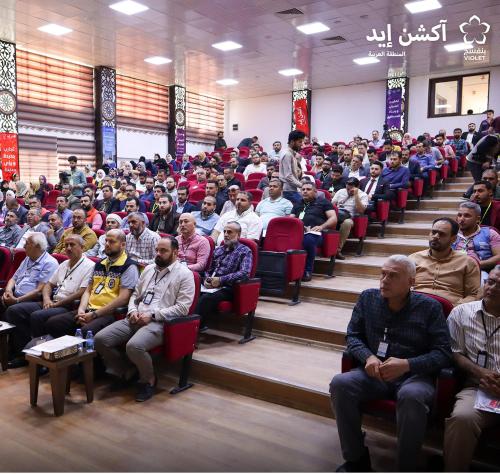
This policy brief symbolises a pivotal moment in post-crisis recovery efforts and serves as a testament to the power of community engagement, local ownership, and participatory decision-making in post-crisis recovery. By centering the voices of youth, women, and crisis-affected people, we can forge a path towards a resilient, inclusive, and sustainable future, where the scars of the past are healed, and communities can thrive once again.
Background
More than a decade after the onset of the Syrian conflict, humanitarian needs in the country remain at an all-time high, and civilians continue to be subjected to crises and shocks. In February 2023, Northwest Syria was hit by one the biggest earthquakes of the last century. More than 4,500 people were killed, and thousands of essential buildings were destroyed. The earthquake compounded an already dire humanitarian crisis, and exacerbated existing vulnerabilities that civilians in Northwest Syria were experiencing. Northwest Syria has been subject to multiple military offensives by the Syrian-Russian military alliance over the last twelve years which displaced and killed hundreds of thousands.
The COVID-19 pandemic as well as the conflict in Ukraine only complicated the crises experienced in the region, resulting in unprecedented economic deterioration and inflation. Today, around 4.5 million civilians live in the region, having been subjected to multiple waves of displacement, the loss of homes, families, and livelihoods.
For those in Northwest Syria, their view of the region evolved over the years. At the beginning, many held hope that they would return to their homes elsewhere in Syria. However, as the conflict progressed, it became clear that the likelihood of return was diminishing. As such, Syrians shifted their focus from makeshift and temporary solutions, to identifying ways to rebuild their lives more permanently in Northwest Syria.
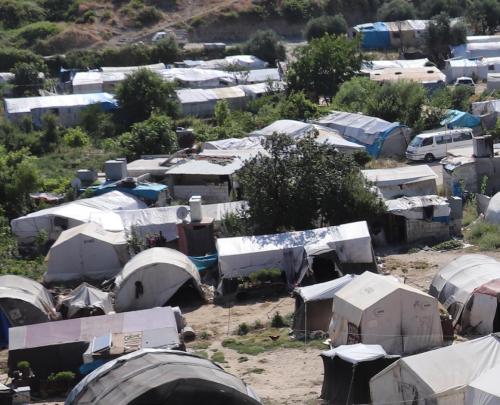
This shift in perspective within the local community has yet to be matched by a global shift in perspective. For one, there remains a political vacuum in the region; the fractionalisation of governance powers coupled with the lack of recognition, and the stalling of a political peace process for Syria has meant that Northwest Syria’s political status remains ambiguous. Northwest Syria is currently one of the few areas that is not under the control of the Syrian regime. Instead, it is governed by a combination of local actors, including Turkish-backed anti-government groups and the Salvation government, the civilian arm of Hay’et Tahrir al-Sham, a proscribed group. Several cities and towns in Northwest Syria have local councils that run the day-to-day operations, and act as the primary interlocutor with humanitarian organizations, but these bodies are not recognized by the international community and have limited power beyond their territories.
The governance structure within Northwest Syria has meant that humanitarian operations there often occur in a piecemeal fashion, subject to access restrictions and varied requirements by the governing forces in each area.
While the extent to which access is encumbered in Northwest Syria is less than that faced by humanitarians in the Syrian Regime-held areas, it remains an obstacle. The tenuous status of the region and the lack of recognition by the international community translates into hesitation on the part of states and the United Nations, as well as international humanitarian organisations, to scale up humanitarian operations locally.
Nowhere is this dynamic clearer than in the cross-border operations in Northwest Syria. In 2014, and in response to the Syrian regime’s refusal to allow access to opposition-held areas, the UN Security Council passed a resolution that would allow UN agencies to provide humanitarian aid across borders without requiring the government’s permission. In the years since, that resolution has been gutted, and only one out of four border crossings remain operational. Following the earthquake, the Syrian regime provided permission for two additional border crossings, but the threat of closure today is imminent. On July 11, 2023, Russia used its seventeenth veto to prevent a resolution calling for the renewal of the sole remaining border crossing for another 12 months. The move is widely considered as signaling the demise of the cross-border operations. The Syrian Regime proposed to allow the United Nations to use one of the border crossings for a period of 6 months, but only through full cooperation and coordination with them. Their proposal would require the fulfillment of multiple conditions that the UN, humanitarians, and others condemned as unacceptable, given the Syrian regime’s history of weaponising humanitarian aid to punish opponents and the serious violations of human rights and international humanitarian law committed by the Syrian government against the civilian population in Northwest Syria and elsewhere.
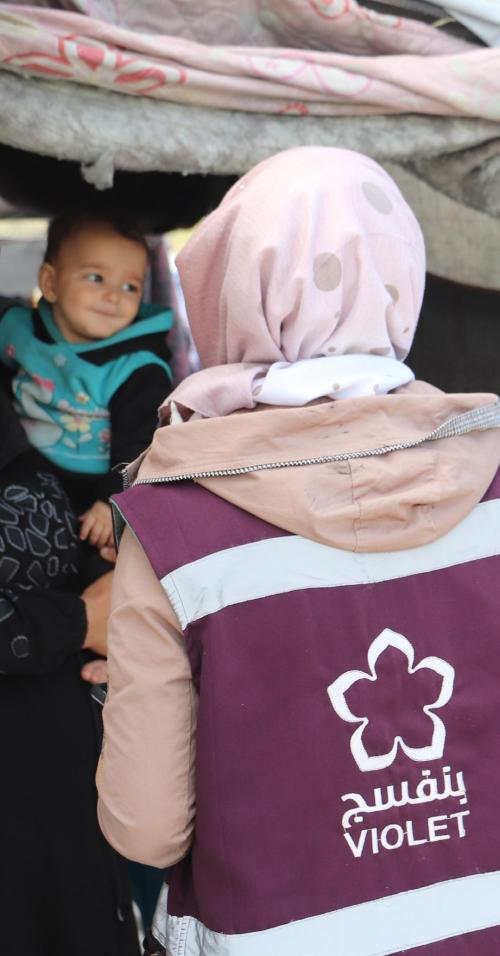
The uncertainty surrounding cross-border access, coupled with the hesitation of humanitarian agencies to enter Syria without government permission, has placed undue strain on operations in Northwest Syria. This is an illustration of how the tenuous status of the region internationally has ramifications for the ability to scale up and make sustainable humanitarian programming. The region has been subject to a series of manmade and natural crises – the last of which was the February 2023 earthquake. The threat of attacks and incursions by the Syrian-Russian military alliance, as well as other armed groups operating in the area remains significant. The destruction of infrastructure and large-scale displacement that resulted from these crises has set back many of the plans that Syrians had for themselves. It also meant that emergency aid remains at the forefront of humanitarian planning given the immediate needs of the population.
Against this backdrop, this policy paper stands as a determined response to the scarcity of sustainable humanitarian solutions that could provide Syrians the agency and tools necessary to facilitate the pivotal shift towards localised recovery.
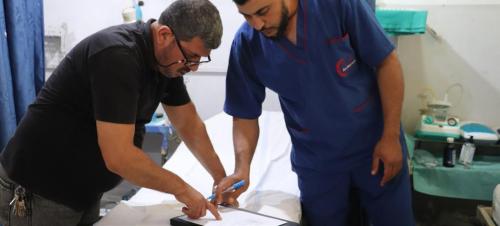
Methodology and providence
This policy paper was developed on the basis of wide- ranging consultations with communities in Northwest Syria. Violet coordinated five community sessions across Northwest Syria, including in Armenaz, A’zaz, Darat Izza, Jisr al-Shugour and Idlib city that were attended by members of the community, local civil society, and humanitarians across a wide-range of ages, and included representation from both women and youth. The sessions culminated in a conference that featured over 200 participants including community leaders, civil society members, youth, women, private sector representatives and members of the international community who worked together to identify and develop recommendations for early recovery in Northwest Syria. The consultations were supplemented by meetings with local humanitarian actors and discussion facilitators who shared their expertise and further provided context for the issues raised by community members.
The policy paper provides a detailed overview of the recommendations identified by community members. This collaborative-iterative approach distills the input of the community directly, with very little reframing to reflect experiences on the ground and provide stakeholders with direct insight into the perspectives of rights-holders. The collaborative-iterative approach adopted seeks to center community voices in building a sustainable strategy for early recovery in Northwest Syria.
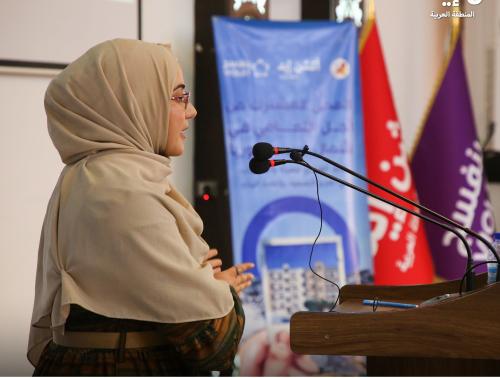
Overview
The consultations shed light on critical aspects of humanitarian operations in Northwest Syria. Participants discussed issues from localisation and participation of affected communities in humanitarian programming to the move from emergency to early recovery and improving the sustainability of humanitarian operations. The recommendations associated with each theme included both substantive and procedural suggestions. The policy paper provides an overview of each theme as discussed by local communities, then elaborates on recommendations.
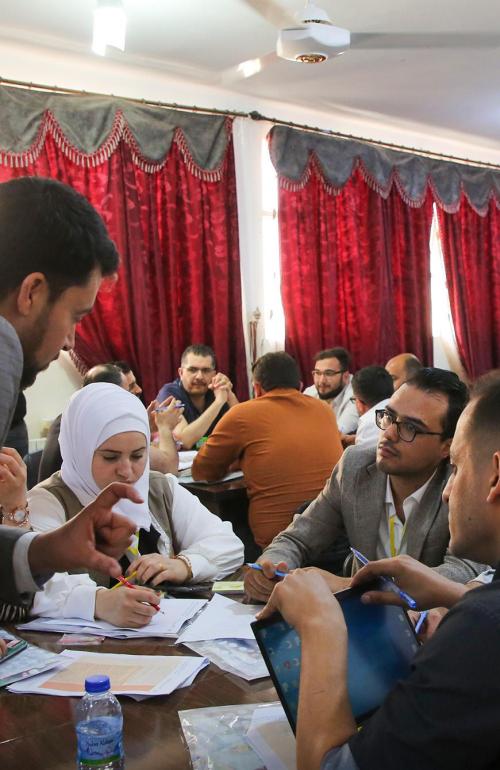
Ending the cycle of vulnerability
Empowering communities to pursue their own well-being rather than remaining dependent on external support should be a cornerstone of any humanitarian
intervention. Youth, women and other affected populations in Northwest Syria have the energy and capacity to contribute to their own livelihoods. An effective humanitarian response would capitalise on that and create sustainable, community-led opportunities for the local population to help itself.
When asked what empowerment looks like to them, rights-holders shared they wanted to focus more on local leadership than local empowerment, as empowerment implied the existence of an external party that lends them power rather than finding that strength and capacity within themselves.
The earthquake highlighted the importance of having local leadership at the forefront. In the aftermath of the earthquake, Northwest Syria faced significant delays in receiving external support, placing a heavy reliance on local leadership and their limited available resources. Local groups were the primary entities responsible for rescue and humanitarian operations. Their ability to act quickly saved lives, even as the inability of the international community to mobilise placed countless at risk. This shows how necessary it is for humanitarian operations to internalise and systematise local leadership - especially as the local communities expect them to respond immediately, despite lack of funding or resources.
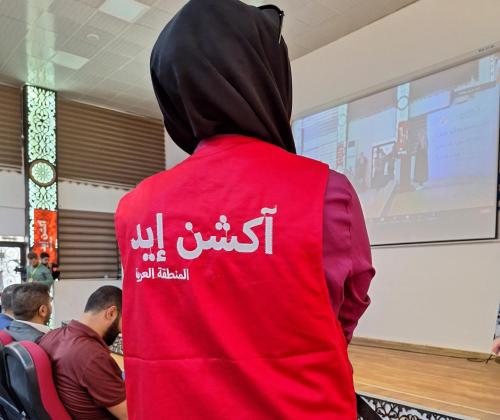
Recommendations
Meaningfully incorporate local perspectives into humanitarian operations.
Localisation of humanitarian efforts must be at the forefront of any humanitarian operational strategy. This means incorporating local voices from start to finish, including in strategy-making, fundraising,implementation, and monitoring and evaluation.
Humanitarian operations can increase their sustainability by ensuring that they cultivate local leadership and focal points that can sustain a commitment to these projects long after a humanitarian organisation or donor has moved on. To do this, humanitarian organisations must ensure that community members are invested in these efforts and able to advance them on their own.
While humanitarian programming often includes consultations with the affected communities as a step in the implementation, participants and humanitarian actors shared that such consultations are often a box-ticking exercise rather than a meaningful engagement that would reflect changes on the program an organisation seeks to implement. This is in part the result of difficulties with renegotiating the framework with donors and higher levels within the humanitarian organisation, and a reflection of the top-down approach that continues to afflict strategy-making in the humanitarian sphere.
Create a local coordination system in Northwest Syria.
Humanitarian operations across Syria benefit from building partnerships and coordination through stronger coordination mechanisms inside Syria, which allow local humanitarian organisations to share information and plans more effectively, assess needs, and avoid duplication across the different humanitarian interventions. Unlike the Northeast and the Syrian regime-held area, the UN-led coordination mechanism for Northwest Syria is not locally based but instead is operated from Turkey. This not only results in delays and obstacles to implementation, but also means that local humanitarian workers are dependent on a one-step removed aid apparatus to communicate and coordinate their operations. The creation of a local coordination system in Northwest Syria, that works in close collaboration with the Turkey-based mechanism, would ensure that information is being received immediately; it would more actively center local voices and ensure that decisions and plans are adapted accordingly to the situation on the ground.
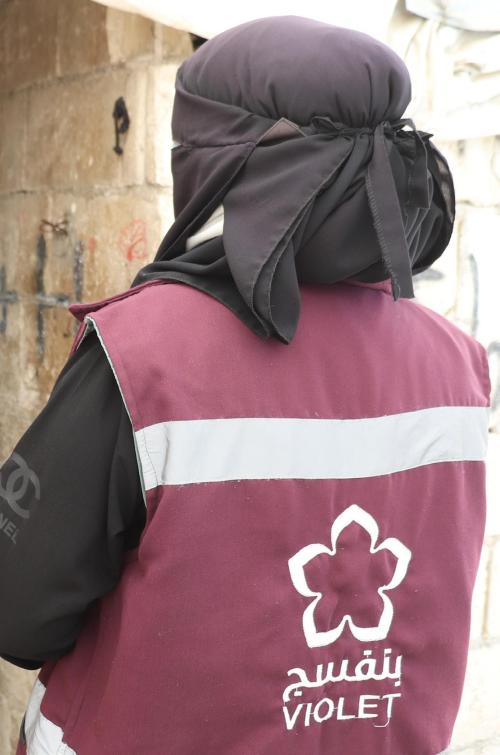
Advance and adapt methods for aid provision to respond to needs on the ground in a way that recognizes the community’s need for sustainable livelihoods.
Localisation within the context of Northwest Syria necessitates that methods for aid provision adapt in response to the shifting expectations on the ground. During the consultations, participants highlighted how during the earthquake, private donors mobilized funds quickly and flexibly to the local population to enable them to make purchases and recruit volunteers to respond to the crisis quickly. They shared that even prior to the earthquake, private individuals provided funds in consultation with the local population, which translated into the funds being more effective and responsive to emerging needs. This meant that the funds were more effective and more responsive.
Large donors can learn from smaller, private donors in how they derive their funding priorities from direct consultations with the local population. They can and should also adapt the way they provide their funding to be more efficient with faster turnaround times and reduced requirements in periods of crisis. This is in part reliant on the need for donors together with humanitarians to set in place policies and procedures that reflect adequate due diligence, while providing necessary staffing and urgency.
Create a locally-driven funding mechanism for Northwest Syria.
In light of the uncertainty surrounding the renewal of the UN cross-border mechanism and the catastrophic impact this would have on humanitarian operations, there is a need to establish a novel and effective funding mechanism that circumvents reliance on external actors and instead vests humanitarian financing decisions and leadership in the local humanitarian actors. Such an approach would secure uninterrupted humanitarian support for the affected populations of Northwest Syria.
The mechanism would be based on a decentralised funding platform that empowers qualified local stakeholders with a track record of effective humanitarian initiatives within the region to access financial resources from a common pool of funds directly.
Critically, the platform would enable humanitarian actors to communicate directly with donors, address population needs, and propose solutions that are derived from and responsive to the context on the ground rather than standardised interventions.
A locally-driven fund would also guarantee a swift and targeted allocation of resources, bypassing bureaucratic obstacles and reaching those in dire need of assistance without delay. The localised funding strategy fosters greater local resilience and paves the way for sustainable, long-term humanitarian aid, even in the absence of broader international mechanisms.
Support people, including women and youth, in Northwest Syria to ensure that they
have the skills and opportunities to pursue sustainable livelihoods; through incorporating long-term employment opportunities and market-oriented educational programs into the response.
One of the major concerns highlighted by consultation participants was the desire to be productive members of society rather than just recipients of aid. While humanitarian initiatives have intermittently introduced cash-for-work engagements and vocational training, feedback from participants suggests that these endeavours often fall short of their intended ambitions.
Rights-holders shared that cash-for-work is not sustainable beyond the lifecycle of the project, either due to the lack of fit with actual market needs or because participants lose motivation to continue working, especially where that work is not part of an employment track. As one participant shared: “We should shift our perspective from cash-for-work to cash-for-production, to encourage a long-term productive mindset.”
Humanitarians shared that the short time-period in which such projects are often required to be implemented means that they do not have enough time or capacity to coach and support rights-holders through their projects or work.
Meanwhile, both humanitarians and rights holders highlighted the issue of redundancy within vocational training initiatives. Participants often undergo identical training from different organisations, lacking coordination that would guarantee the relevance of training vis-a-vis market demands and pre-empt duplications
i) provide training that responds to market-needs
ii) to ensure that the trainings are not duplicative
Rights-holders also highlighted that they have little opportunity to utilize the skills that they learn in the trainings provided, and that the trainings were not recognised locally due to the lack of coordination with technical institutes or universities that could provide accreditation.
By developing and implementing strategies that align with market realities, extend beyond project timelines, and secure formal recognition for acquired skills, organisations can ensure that these programs evolve into robust conduits for sustainable livelihoods and community recovery.
Creating local market-driven solutions and enhancing humanitarian impact through stronger collaboration with the private sector.
Among the rights-holders in the community consultations, a prevailing query emerged regarding the potential to harness the private sector’s presence to infuse sustainable dynamism into humanitarian operations. The private sector has the capacity to create profit and sustain itself but cannot dedicate itself fully to supporting community needs. Humanitarian organisations, on the other hand, remain steadfast in their commitment to improving local livelihoods, but are dependent on external funding which lacks the sustainability and longevity inherent in profit-driven endeavors.
Humanitarians and community participants highlighted a few avenues for strengthening the partnership between humanitarian organisations and the private sector. Many early recovery projects that humanitarian organisations undertake involve supporting right-holders to develop and sell products, or participate in cash-for-work projects. However, the resulting outputs might not garner traction in the market, rendering these projects ultimately unsustainable.
A stronger partnership with the private sector would allow humanitarian organisations to better tailor their projects to support rights-holders to create products aligned with market demands.
Collaborative initiatives bridging the private sector and humanitarian stakeholders can engender pathways for rights holders to generate income by contributing to work commissioned by or indispensable to the private sector. This convergence not only fosters economic self-sufficiency but also anchors lasting sustainability.
There is still much work to be done in cultivating partnerships between the private and humanitarian sector.
An essential first step is creating a space for actors from both sectors to come together to better understand each other’s perspectives, align values and pursue a common strategy.
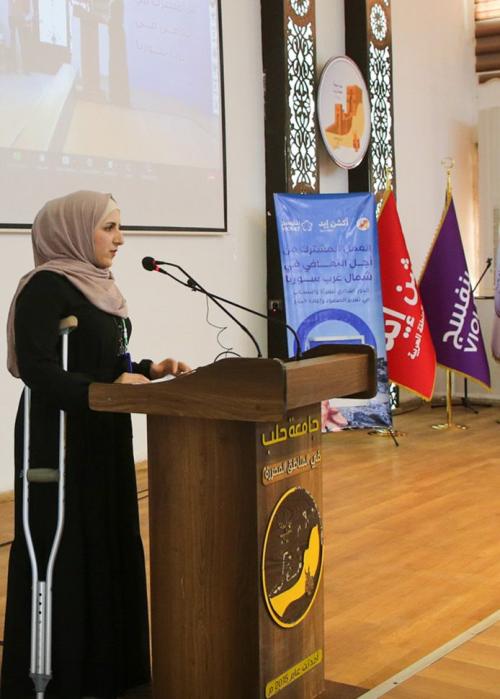
Improve access to education for residents of Northwest Syria.
Closely related to the above, community members urged the international community to support them in improving access to education in Northwest Syria. A critical component of sustainable livelihoods is ensuring that rights-holders are suitably equipped and trained to be productive members of society.
While access to primary education in Northwest Syria has been a focus of the humanitarian community in the last decade, access to secondary education is less prevalent. Donors and organisations should commit to prioritizing financial support for secondary and higher education programs, alongside sustaining their support to primary education, which is still not sufficient.
Such support would move beyond ad-hoc activities to supporting education as a system, which includes sustainable structures, good quality staffing for schools and effective governance. Programs should ensure that support flows to existing institutions, enabling them to continue carrying out their vital educational role.
They should also advocate for the recognition of local universities, as these are often the only avenues available to residents in Northwest Syria to obtain an education. Yet, the absence of recognition for these degrees hinders the potential of aspirants, curtailing their ability to capitalise on their educational attainments. Hence, it becomes paramount to dismantle such obstructions and foster recognition.
Finally, the international community should remove financial barriers to education by creating scholarship programs and other financing initiatives for youth to incentivise them to attend schools.
Programming should also address removing cultural and political barriers to education.
Girls and women still face significant barriers to access to primary and secondary education. Humanitarian organisations should work with local community leaders to help overcome these obstacles to girls’ education, including by guaranteeing a safe space for girls, raising awareness with relatives and the community, and supporting mentoring programs.
By combining these efforts, the international community can make significant strides in empowering affected youth and promoting inclusive and equitable access to education in Northwest Syria.
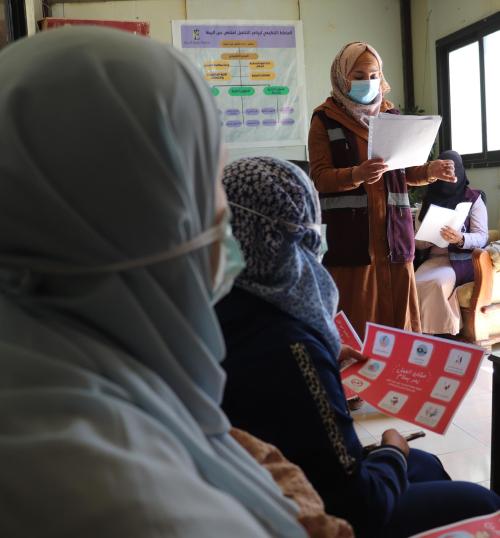
Balance emergency aid with early recovery efforts
Integrating early recovery into humanitarian programming while ensuring that the fulfillment of basic needs remains a priority. Over 4 million people live in Northwest
Syria and want to begin building their lives fully and have the right to do so given the protracted nature of the crisis. At the same time, given the compounded emergencies that Northwest Syria has experienced, immense humanitarian needs remain on the ground.
This juncture calls for a nuanced equilibrium—one that pivots from exclusively tending to emergencies to embrace the reconstruction of pivotal infrastructure and advances in sustainable development. Concurrently, moving towards early recovery without attention to the population’s basic needs will result in gaps in the humanitarian response.
Recommendations
Proactively address the political and financial challenges to integrating early recovery seamlessly into the response in Northwest Syria.
There are a number of challenges that prevent a seamless transition to early recovery in
Northwest Syria. Irregular access, complicated by threats to the cross-border mechanism, and continued instability and violations of human rights, means that humanitarian agencies have little insight into how long they will be able to serve populations in need, thereby hindering their ability to plan in the long term.
As such, the international community should advocate for regular and unfettered access to Northwest Syria through the cross-border mechanism.
Many parties to the conflict have committed violations of human rights and international humanitarian law. Some are also prescribed groups. For donors, this translates into a hesitation to scale up funding or look at early recovery efforts, for fear that these may be co-opted or used to further entrench rights violations. As such, financial and political transparency should be a condition of all humanitarian operations. However, this must not serve as a setback in providing urgent support which can further exacerbate the plight and suffering of affected people. While donors may have legitimate concerns about the potential misuse of funds, it is essential to systemise oversight operations in such a way that does not hinder the provision of urgent support, and allows for expediting the delivery of aid, especially in emergency contexts, where flexibility and responsiveness is critical.
To achieve this balance, donors and humanitarian organisations must adopt a proactive approach that allows for immediate assistance while also establishing transparent and independent reporting and oversight mechanisms. These should not be viewed as a burdensome bureaucratic process but rather as an integral part of responsible and effective humanitarian operations. Transparency and accountability can bolster trust between donors, aid organisations, and affected communities, ensuring that resources are utilised effectively and ethically.
Participants have highlighted their important roles in increasing trust and confidence about the use of humanitarian funds, by not acting as passive recipients of aid but active stakeholders who should be engaged, empowered, and included in decision-making processes.
This will guarantee oversight and monitoring of aid utilisation, transparency, and accountability. This is further strengthened through local Syrian organizations’ acquired experience in compliance management, and zero-tolerance policies for corruption, fraud, and any misuse of funds.
The policy paper also mentions the above question of political challenges. As mentioned above, the lack of a clear, recognised solution to the status of Northwest Syria, and the fragmentation of governance actors creates serious obstacles for sustainable humanitarian operations. Localising humanitarian efforts in a way that bypasses the political vacuum and committing to advocating for a more prominent role for the local population would be one pathway to mitigating these complications.
Develop a comprehensive and multi-sectoral strategy for early recovery, recognising the interconnectedness of different sectors such as livelihoods, infrastructure, health, education, and governance, and the complexities of the reality on the ground.
For the participants, one of the clear gaps in humanitarian operations thus far was the lack of coordination and centralised strategic planning. Both rights-holders and humanitarian participants recognized that shifting towards early recovery programming fully required a comprehensive and multi-sectoral strategy that
1) took into consideration the interconnectedness of the different sectors and
2) the different actors operating in Northwest Syria, and establishing who can and should play a role both in setting and implementing the strategy.
Such factors include local councils, local civil society, governance actors and the private sector in addition to the rights-holders themselves.
Any strategy development would need to encompass all humanitarian operations in Northwest Syria to avoid redundancy and ensure that the strategy is effective to find the best way to utilise the limited available resources. It should start with a contextualised and comprehensive needs assessment.
Respondents across the board indicated that they felt that needs assessments that were currently conducted in the humanitarian context have not delved into the underlying root causes of issues, and merely focused on gaps and needs, hindering the necessity of unlocking solutions. Humanitarian organisations must urgently commit to a transformative approach in conducting needs-assessments, incorporating the authentic voices and perspectives of the communities affected who hold invaluable insights into the root causes of the problems they face daily, and their first-hand experiences lay the groundwork for sustainable solutions.
Rights-holders also addressed the short-term nature of the projects; in their experience, the combination of short-term projects and bureaucratic requirements mean that there is a short turnaround with projects. A comprehensive strategy would incorporate medium to long-term projects.
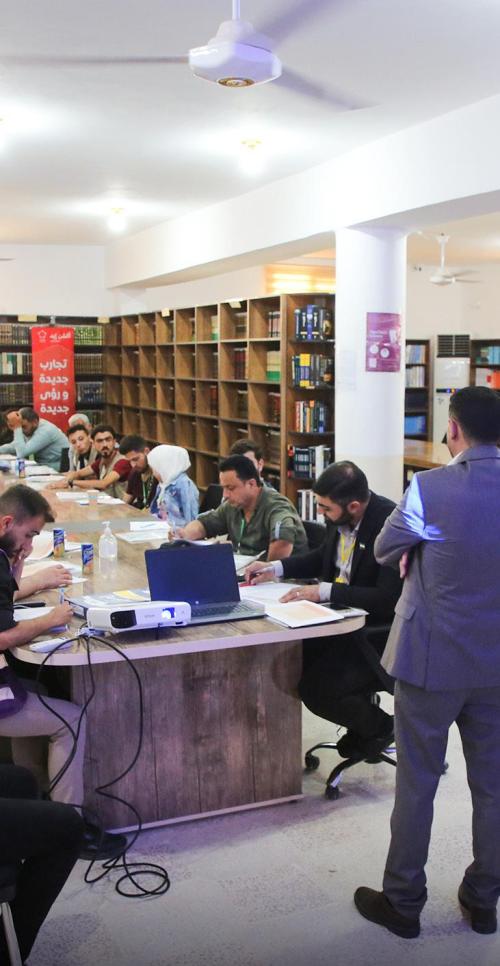
Maintain a degree of funding flexibility to enable response to urgent needs and emergency situations.
Northwest Syria remains subject to crises, and therefore precipitates a degree of funding flexibility to be incorporated into existing programing. As one humanitarian recalled, following the February 2023 earthquake, some organizations were able to mobilise resources almost instantaneously on the ground because their donors provided them with enough emergency-flexibility to shift their existing financial resources. Others, including several UN agencies, needed months before they were able to mobilise resources towards earthquake-related projects in Northwest Syria. Such a delay was costly to the local population, and by the time that those funds were released, the needs on the ground had changed significantly, making that project less effective.
Donors’ commitment to bettering the circumstances of rights-holders in Northwest
Syria should include a recognition of the fact that early recovery alone would not be sufficient to meet the needs of the local population. Aid should operate on parallel tracks: supporting early recovery for more sustainable, long-term results, while maintaining support for the population’s immediate needs.
Sustainable recovery efforts are predicated on the meaningful inclusion of marginalised populations and affected communities. While humanitarian projects often mention women and youth in their projects, they rarely tailor their gender or youth-based interventions to fit the local context in which they operate.
An effective and inclusive humanitarian response cannot transpose inclusion solutions into the local context without taking into consideration the specific cultural and socioeconomic realities of the region.
Recommendations
Ensure that humanitarian programming that targets women responds to their primary problems as defined by them.
Critical to the successful inclusion of women and youth in humanitarian projects generally, and early recovery in particular, is the incorporation of the aspirations of women and youth into the outputs of the program, and an understanding of how local dynamics enable or hinder women/youth empowerment.
Both rights-holders and local humanitarians in Northwest Syria shared that many of the humanitarian interventions that target women fail to capture and respond to women’s primary concerns. When asked to identify their priorities, those consulted said they wanted a regular source of income. While early recovery programming does involve projects that seek to provide income for women, they can be less effective than expected due to their short-term nature and the fact that many women face obstacles in being able to access and take advantage of these opportunities. A more effective approach would include helping women remove obstacles in their path to being productive members of society, be it through providing transportation, assurances of a secure and safe working environment for them, or the provision of childcare.
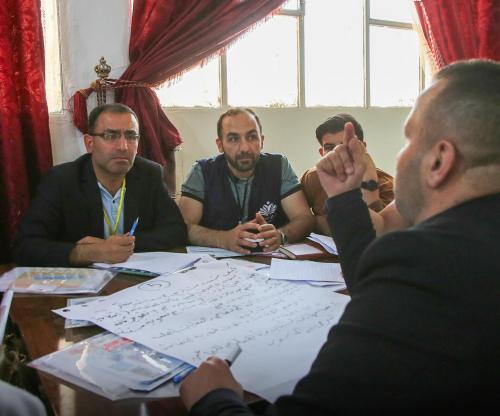
Develop a conceptualisation of women empowerment that is rooted in and responds to local dynamics.
Concurrently, the procedural aspects of gender-based projects were seen as culturally inflexible and unresponsive to local dynamics. Rights-holders shared that the types of activities that humanitarian organisations promoted for the empowerment of women felt forced and not in tune to the cultural context in the region. This often resulted in a rejection of it by the community.
They highlighted how difficult it was to address these challenges using existing benchmarks and modes of operation, which do not consider the conservative nature of the working environment in Northwest Syria and instead work against it.
A more effective approach would seek to understand the barriers to women and youth empowerment that are specific to Northwest Syria, and to work with the affected communities themselves to identify solutions and pathways for empowerment. This entails avoiding transposing solutions from other contexts into Northwest Syria and creating a safe and accommodating environment for women to be able to participate without creating tension with the rest of the community.
Identify better pathways for access to women in the Syrian context and create a safe environment to promote active and sustainable participation.
When asked what meaningful participation of women meant to rights-holders, they shared that they wanted an active, decision-making role in early recovery and governance-related projects. To them, consultations or token inclusions were not sufficient. Instead, they wanted to be trained and supported to take on roles that can more actively influence outcomes.
They shared that many humanitarian organizations do not make space for or actively recruit Syrian women in decision-making roles, except where the projects are gender-related, or where the organization is primarily concerned with women’s rights. This oversight means that women’s perspectives are often not meaningfully included in mainstream humanitarian programming.
Finally, a critical component to identifying better pathways for women is ensuring that there is a safe space for women to be able to share their perspectives, learn and grow.
Safety as a concept should be derived from what women in the region perceive as necessary. This may be different from mainstream or international conceptualisations of safe environments (for example, women may want a segregated space for consultation and training).
Incorporate collective-targeting and community-led strategies into early recovery and humanitarian programming.
Early recovery projects like cash-for-work and vocational training often target individuals, rather than a collective/community-level approach. Among the suggestions during the consultations was the reconceptualisation of these projects to engage society at a collective level. A collective (community-level) approach would seek to incorporate a more diverse array of actors, and challenge aid operations to identify and seek out previously inaccessible populations. In this context, participants highlighted that diversity is intended to include those rights-holders who have not benefited from the activities beforehand and different classes of youth, including those with and without a college education as current early recovery activities appear to exclude them.
A collective approach would also mean incorporating actors beyond rights-holders in the planning and implementation of a program. For example, whereby the training would occur for the community, and in line with the demands of the private sector operating in that area and with the support of educational institutions to gain accreditation. Similarly for microfinance or cash-for-work projects, these projects should be adopted only when they fit into a larger plan that connects the different segments of society in a way that makes it sustainable.
Finally, such an approach would naturally accept that project cycles require longer periods than emergency or regular humanitarian interventions.
Building Resilience in Northwest Syria
Recognising that Northwest Syria has been subjected to multiple shocks and that there are no guarantees that additional crises will not occur, humanitarian programming and early recovery strategies should prioritize building resilience on the ground.
Resilience in this context is predicated on explicitly addressing the risks that could threaten progress already achieved and reflecting an understanding of the dynamics of operating in the region. It would also include ensuring that civil society organizations including women and young people are empowered and capable of leading in emergency situations on the ground. Unleashing the local potential and empowering larger local humanitarian actors to empower grassroot civil society actors, movements, or individuals is a win-win approach which promotes localisation and empowers local communities, laying the foundation for long-term transformative change.
Recommendations
Strengthen grassroots civil society to ensure representation and localisation.
Building resilience through smaller grassroots civil society organizations is a pivotal approach to ensuring localisation and representation in crises. These organisations are deeply rooted in the various communities of the Northwest of Syria and possess a unique understanding of local needs, challenges, and cultural nuances. By supporting these organisations, the humanitarian community can harness these organisations’ inherent strengths and deep community connections to foster sustainable recovery and resilience. Smaller grassroots civil society organisations are able to identify and respond to specific needs and priorities that may be overlooked by larger, external actors.
Their localised knowledge and proximity to affected individuals allow for more targeted and effective interventions, ensuring that resources are allocated in a way that directly benefits the most vulnerable and marginalised populations.
They have the advantage of being agile, adaptable, and responsive to rapidly changing circumstances. Their flexible structures enable them to quickly mobilise resources, adapt programs, and engage with the community in real-time, allowing for timely and contextually relevant interventions.
This localised approach fosters a sense of ownership and empowerment among the community members, as they actively participate in decision-making processes and contribute to shaping their own recovery journey. This applies equally for women-led grassroots organizations, which are often more trusted by women and the community at-large, and as such have greater access and effectiveness when making interventions.
The humanitarian community can support and strengthen grassroots civil society organisations through collaboration with larger local stakeholders and humanitarian actors. By forging partnerships between these entities, we can leverage the resources, expertise, and influence of larger actors to enhance the capabilities and reach of grassroots organisations. This collaborative approach allows for a synergistic exchange of knowledge, resources, and networks, enabling grassroots organisations to expand their impact, access additional funding, and navigate complex challenges more effectively.
The combined efforts of these diverse actors foster a comprehensive and inclusive response, empowering grassroots organisations to effectively address local needs, drive sustainable change, and build resilient communities from the bottom up.
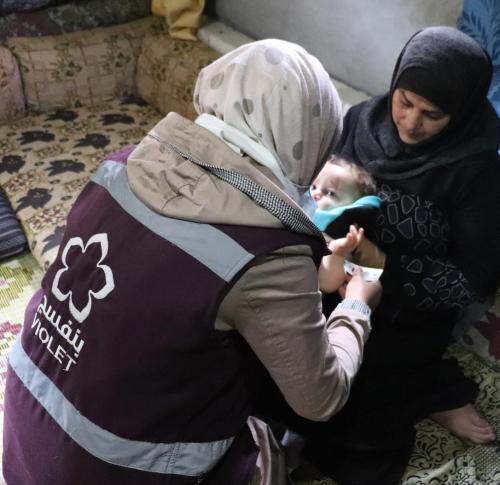
Advocate publicly and privately for a more stable, safe, and rights-respecting environment in Northwest Syria to reduce the risk that communities are exposed to additional crises.
Syria poses a difficult operating environment for humanitarian actors due to continued rights violations, destruction of infrastructure and lack of a viable political solution. The tenuous situation in Northwest Syria in particular means that even where humanitarian operations achieve their desired result, there are external factors that can act as setbacks. As such, humanitarian actors, their donors and states should continue to advocate privately and publicly for a safe and rights-respecting environment in addition to refining their operations.
Incorporate risk reduction and resilience measures into recovery strategies to support communities’ capacity to withstand future shocks.
There are no guarantees that natural or man-made disasters will not impact Northwest Syria in the foreseeable future. Already communities are affected by the consequences of climate change, including flooding and fires.
Humanitarian actors, and their donors, should ensure that recovery strategies explicitly acknowledge such a possibility and incorporate measures that allow communities to withstand future shocks. Such measures would include provisions for funding flexibility, operational plans for allowing local aid actors to develop and implement emergency plans independently, and periodic review of supplies and improved data collection on critical developments.
Incorporate local actors’ capacity into humanitarian programming, as well as preparedness capacity, as they are often the first line of defense against crises and shocks.
In Northwest Syria, local actors act as a necessary intermediary between international humanitarian actors and the larger population. Per community consultations, the role of these vital intermediaries including local organisations, educational institutions, unions, professionals, and community representatives in early recovery and humanitarian programming strategies is often ambiguous and undefined.
Given the essential role that these actors play, and their knowledge of the operational dynamics in Northwest Syria, recovery strategies should explicitly include them by:
i) soliciting their feedback and perspective on regional priorities.
ii) allowing them to act as focal points for the implementation of projects.
iii) equipping them with the skills and capacities to monitor, evaluate and revise humanitarian interventions in partnership with affected communities and the humanitarian organisations themselves.
